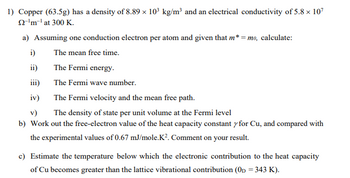1) Copper (63.5g) has a density of 8.89 × 10³ kg/m³ and an electrical conductivity of 5.8 x 107 2¹m¹ at 300 K. a) Assuming one conduction electron per atom and given that m*=mo, calculate: i) The mean free time. ii) The Fermi energy. iii) The Fermi wave number. iv) The Fermi velocity and the mean free path. v) The density of state per unit volume at the Fermi level b) Work out the free-electron value of the heat capacity constant y for Cu, and compared with the experimental values of 0.67 mJ/mole.K². Comment on your result. c) Estimate the temperature below which the electronic contribution to the heat capacity of Cu becomes greater than the lattice vibrational contribution (OD = 343 K).
1) Copper (63.5g) has a density of 8.89 × 10³ kg/m³ and an electrical conductivity of 5.8 x 107 2¹m¹ at 300 K. a) Assuming one conduction electron per atom and given that m*=mo, calculate: i) The mean free time. ii) The Fermi energy. iii) The Fermi wave number. iv) The Fermi velocity and the mean free path. v) The density of state per unit volume at the Fermi level b) Work out the free-electron value of the heat capacity constant y for Cu, and compared with the experimental values of 0.67 mJ/mole.K². Comment on your result. c) Estimate the temperature below which the electronic contribution to the heat capacity of Cu becomes greater than the lattice vibrational contribution (OD = 343 K).
Related questions
Question
PLEASE HELP WITH THIS QUESTION

Transcribed Image Text:1) Copper (63.5g) has a density of 8.89 × 10³ kg/m³ and an electrical conductivity of 5.8 x 107
22-¹m-¹ at 300 K.
a) Assuming one conduction electron per atom and given that m*=mo, calculate:
i)
The mean free time.
ii)
The Fermi energy.
iii)
The Fermi wave number.
iv)
The Fermi velocity and the mean free path.
v)
The density of state per unit volume at the Fermi level
b) Work out the free-electron value of the heat capacity constant y for Cu, and compared with
the experimental values of 0.67 mJ/mole.K². Comment on your result.
c) Estimate the temperature below which the electronic contribution to the heat capacity
of Cu becomes greater than the lattice vibrational contribution (OD = 343 K).
Expert Solution
This question has been solved!
Explore an expertly crafted, step-by-step solution for a thorough understanding of key concepts.
Step by step
Solved in 4 steps

Follow-up Questions
Read through expert solutions to related follow-up questions below.
Follow-up Question
PLEASE HELP WITH QUESTION 1.a) iv, v, b and c

Transcribed Image Text:1) Copper (63.5g) has a density of 8.89 × 10³ kg/m³ and an electrical conductivity of 5.8 x 107
22-¹m-¹ at 300 K.
a) Assuming one conduction electron per atom and given that m*=mo, calculate:
i)
The mean free time.
ii)
The Fermi energy.
iii)
The Fermi wave number.
iv)
The Fermi velocity and the mean free path.
v)
The density of state per unit volume at the Fermi level
b) Work out the free-electron value of the heat capacity constant y for Cu, and compared with
the experimental values of 0.67 mJ/mole.K². Comment on your result.
c) Estimate the temperature below which the electronic contribution to the heat capacity
of Cu becomes greater than the lattice vibrational contribution (OD = 343 K).
Solution